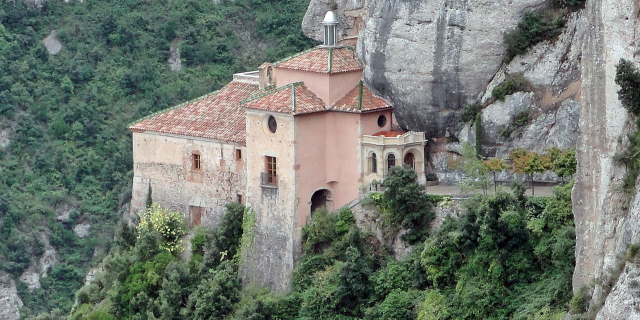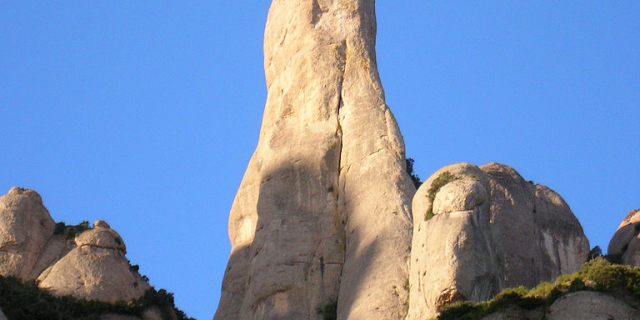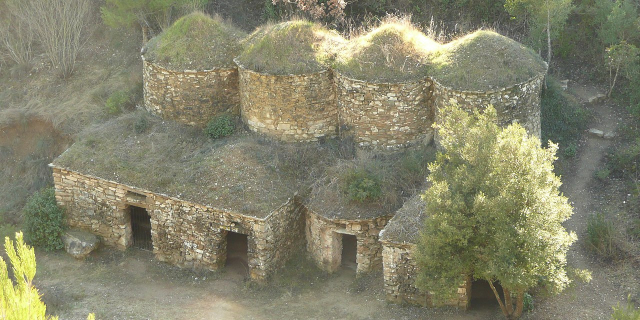Monestir de Montserrat
( Santa Maria de Montserrat Abbey )Santa Maria de Montserrat (Catalan pronunciation: [ˈsantə məˈɾi.ə ðə munsəˈrat]) is an abbey of the Order of Saint Benedict located on the mountain of Montserrat in Monistrol de Montserrat, Catalonia, Spain. It is notable for enshrining the image of the Virgin of Montserrat. The monastery was founded in 1025 and rebuilt between the 19th and 20th centuries. With a community of around 70 monks, the abbey is still in use to this day.
The legend places the finding of the statue of the Virgin of Montserrat around 880.[1] Then began the cult of the Moreneta virgin, which materialized in four earlier hermitages in the 9th century: Santa Maria, Sant Iscle, Sant Pere and Sant Martí. However, the origin of the monastery is uncertain. It is known that around 1011 a monk from the monastery of Santa Maria de Ripoll came to the mountain to take charge of the monastery of Santa Cecília de Montserrat, thus leaving the monastery under the orders of Abbot Oliba of Ripoll. Santa Cecília did not accept this new situation, so Oliba decided to found the monastery of Santa Maria in the place where there was an old hermitage of the same name (1025). As of 1082, Santa Maria gained an abbot of her own and ceased to depend on the abbot of Ripoll. This hermitage had become the most important of all those that existed in the mountain thanks to the statue of the Virgin that was venerated in it since 880.
In 1811 and in 1812, during Napoleon's invasion of Spain, the abbey was twice burned down and sacked by Napoleon's troops, and many of its treasures were lost. In 1835, the abbey was closed until restoration in 1844.
In 1880, Montserrat celebrated 1000 years of existence. On 11 September 1881, to coincide with the Catalan national day Pope Leo XIII proclaimed the Virgin of Montserrat patron of Catalonia.
Spanish Civil War The abbey as seen from the Funicular de Sant Joan
The abbey as seen from the Funicular de Sant JoanThe Spanish Civil War saw the violent suppression of the Abbey of Montserrat. Of the 278 priests and 583 religious men and women killed in Catalonia by Republican forces,[2] 22 were monks of the Abbey of Montserrat.[3] The Spanish Republican authorities and the authorities of the Generalitat de Catalunya, such as Lluís Companys, Ventura Gassol and Joan Casanovas, tried to stop anticlerical violence and helped many priests and religious people to hide and leave the country.[4]
Francoist eraThough Franco never accepted Hitler's invitation to join WWII on the Axis side, Nazi leaders were regular visitors to Spain. During a visit to Spain in 1940, Heinrich Himmler, the head of the Schutzstaffel, took the opportunity to visit the monastery of Santa Maria de Montserrat.[5]
During the rule of Francisco Franco, Santa Maria de Montserrat was seen as a sanctuary for scholars, artists, politicians and students. Franco's men were often waiting for wanted people a few miles down the road.[6]
From the 1940s onward, Santa Maria de Montserrat Abbey was often seen as a symbol of Catalan nationalism.[7] On 27 April 1947, a Mass was held to celebrate the Enthronement of the Virgin of Montserrat, and attended by over 100,000 people.[7] At the Mass, prayers were publicly said in the Catalan language, defying the government's language policies.[7]
Amid other activities, the Abbey of Montserrat played a remarkable part in continuing to publish in Catalan. They created and promoted, among others, some children's publications (L'Infantil, Tretzevents) and some cultural and religious journals (Serra d'Or, Qüestions de vida cristiana). In 1958, tile Abbey founded the Estela Press to promote religious books in Catalan (Masot i Muntaner, 1986). In 1971 the PAM Press (Publications of the Montserrat's Abbey) became official (Faulí, 1999, pp. 35–9). The abbey was also active in providing shelter to intellectuals and clandestine political activists from a wide political spectrum.[8]
In December 1970, 300 Spanish artists and academics held a sit-in at the abbey to protest against the death sentences meted out to 16 Basque ETA terrorists in Burgos. In response, the police sealed off the monastery.[9][10] The protesters were eventually removed from the monastery grounds, but their actions helped convince the Francoist government to commute the death sentences.[11]




































Add new comment